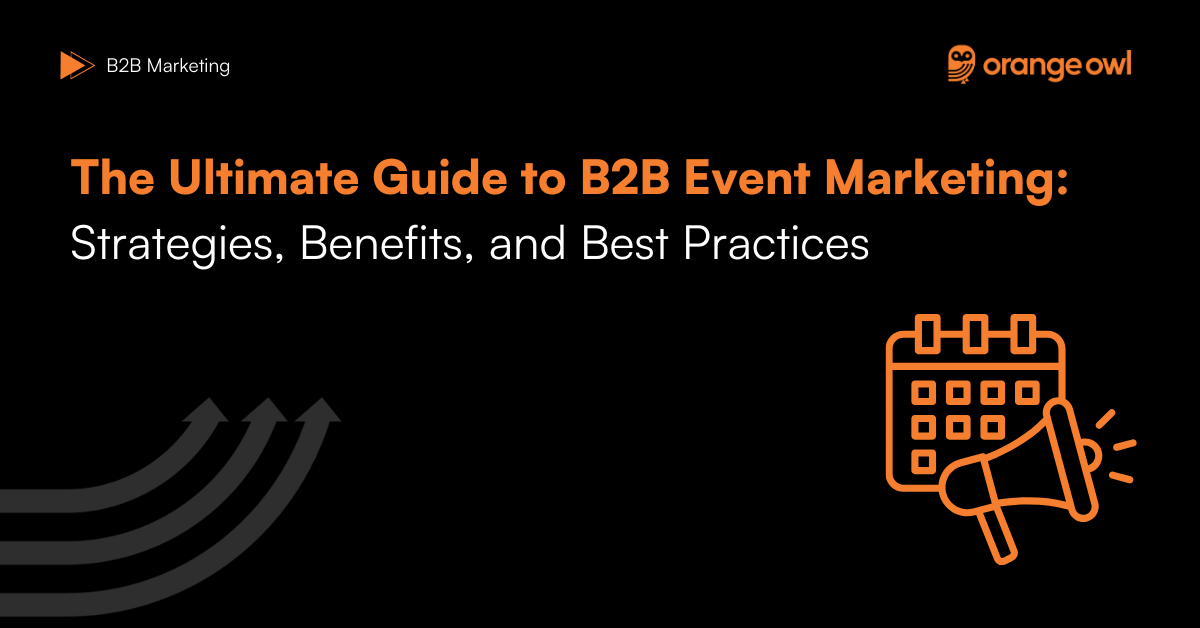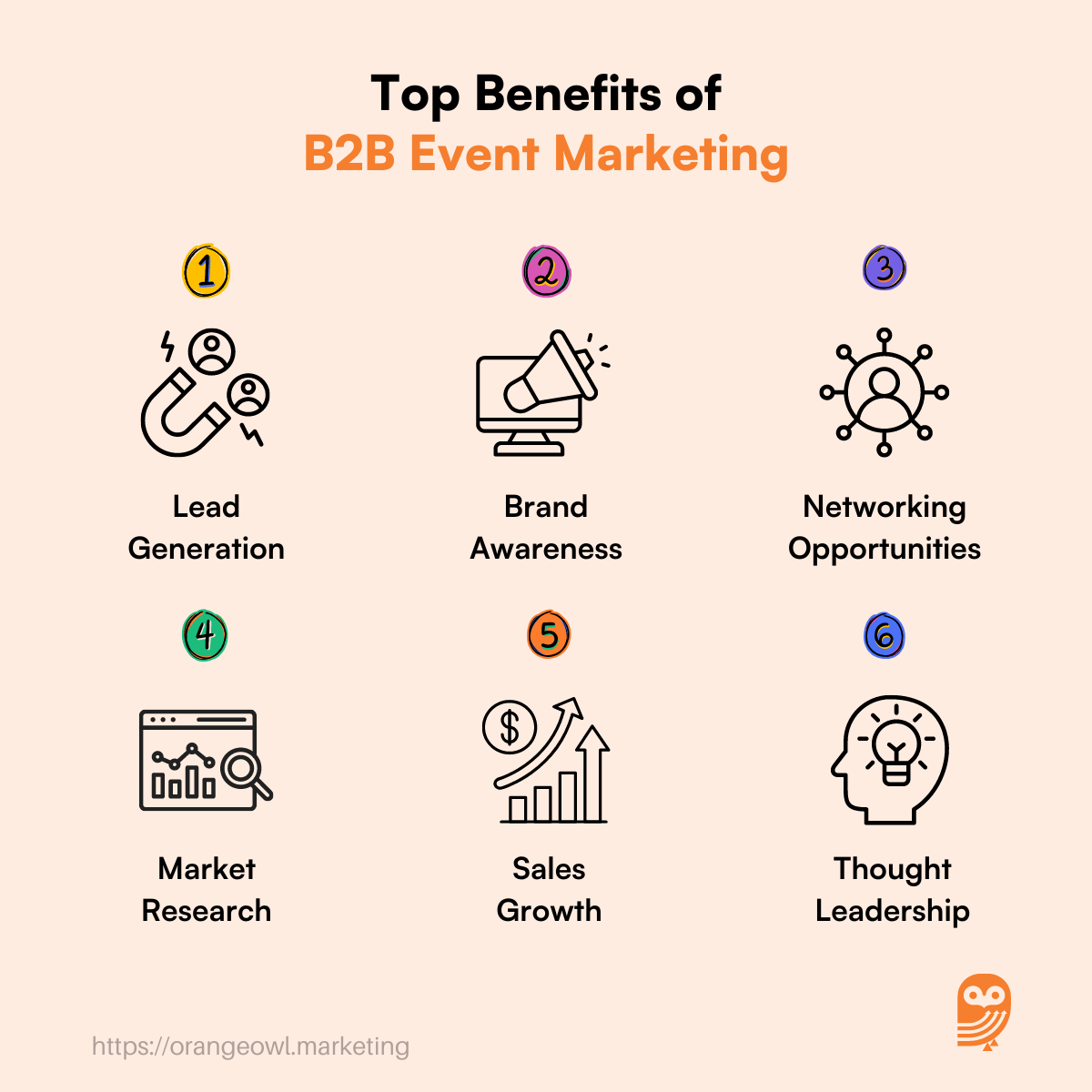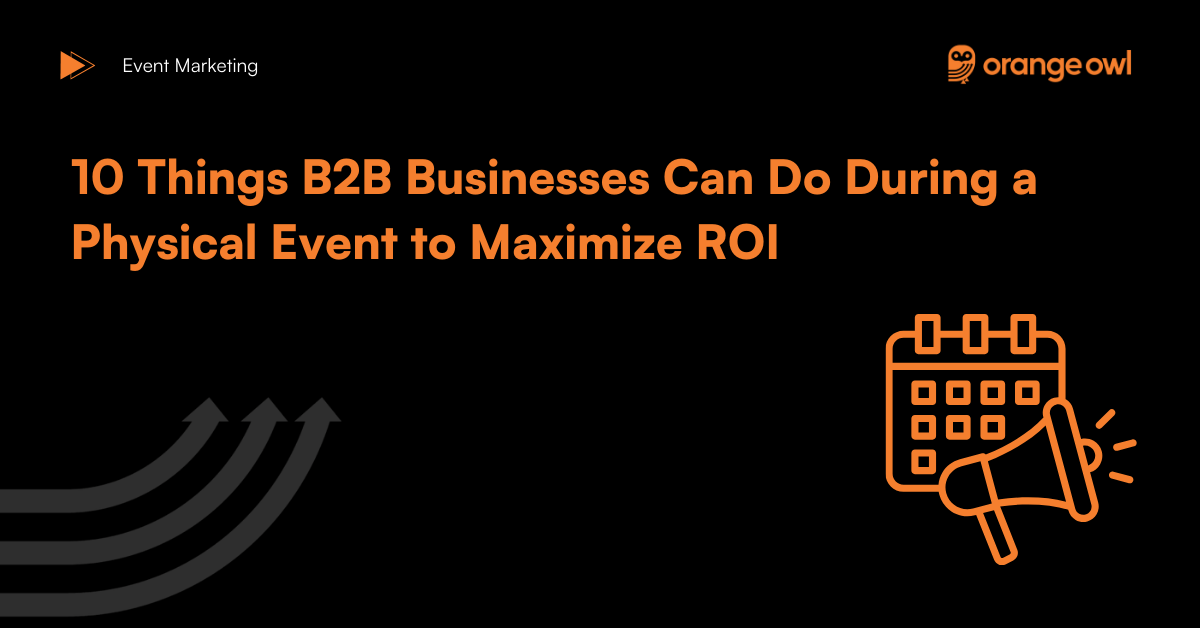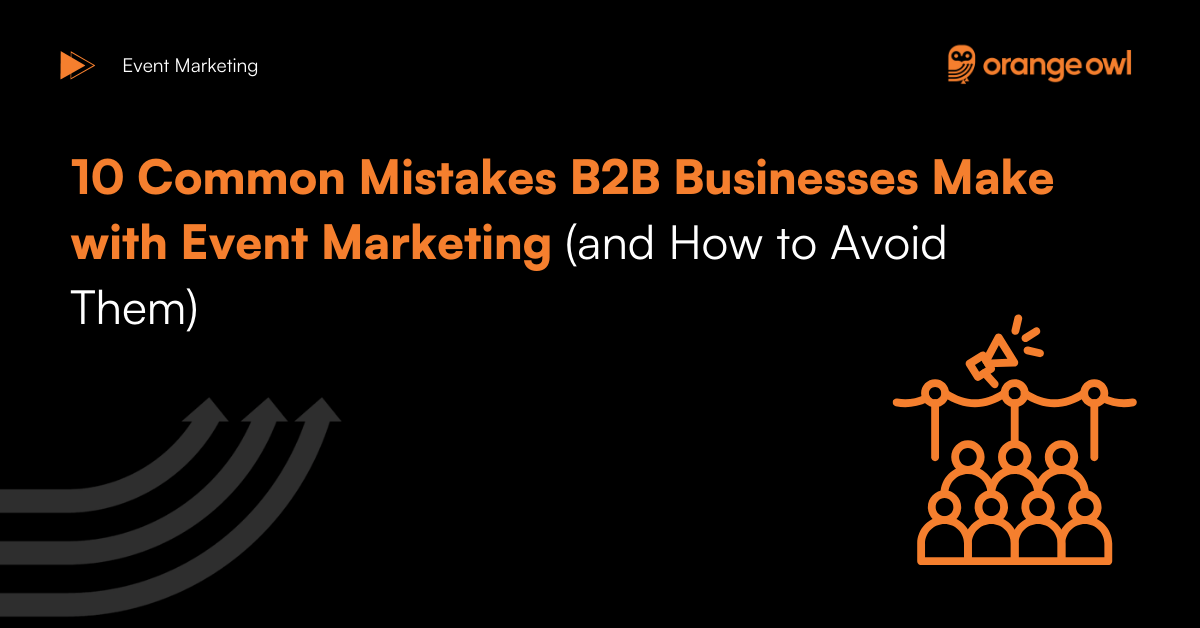The Ultimate B2B Event Marketing Guide: Strategies, Benefits, and Best Practices
Vivek Goel
July 6, 2024

Table of Contents
What is B2B Event Marketing?
B2B event marketing involves creating and managing events to promote a brand, product, or service to other businesses as part of a comprehensive Go-to-Market (GTM) strategy. These events can range from large-scale trade shows and conferences to smaller, more intimate VIP dinners and webinars. The goal is to generate leads, build relationships, and enhance brand visibility within the business community, all while effectively launching and positioning your product in the market.
Benefits of B2B Event Marketing

- Lead Generation: Events provide an excellent platform for generating high-quality leads. Attendees are often decision-makers or influencers within their organizations, making them valuable prospects.
- Brand Awareness: Hosting or participating in events increases your brand’s visibility and credibility. It’s an opportunity to showcase your expertise and position your company as a leader in your industry.
- Networking Opportunities: Events offer a unique chance to build and strengthen relationships with potential clients, partners, and industry influencers.
- Market Research: Events allow you to gather feedback and insights directly from your target audience. This can inform your marketing strategies and product development.
- Sales Growth: By demonstrating your products and services in a hands-on environment, you can effectively drive sales and close deals faster.
- Thought Leadership: Speaking at or hosting events positions your company as an industry authority, enhancing your reputation and influence.
Types of B2B Events
1. Trade Shows
Trade shows are large events where businesses in a specific industry showcase their products and services. They are an excellent opportunity for networking, lead generation, and brand promotion.
- Benefits: High visibility, networking, lead generation.
- Best Practices: Invest in a visually appealing booth, offer engaging demonstrations, and collect attendee information for follow-up.
2. Conferences
Conferences are large-scale events that include expert speakers, workshops, and networking sessions. They focus on sharing knowledge and fostering industry connections.
- Benefits: Knowledge sharing, networking, brand positioning.
- Best Practices: Choose relevant topics, secure high-profile speakers, and provide valuable takeaways for attendees.
Check out the list of top marketing conferences.
Check out the List of Top B2B Conferences and Events in India
3. Roadshows
Roadshows involve taking your event on the road, visiting multiple locations to reach a broader audience. These are effective for targeted regional marketing.
- Benefits: Regional reach, personalized interactions.
- Best Practices: Tailor the content to each location, create engaging presentations, and ensure logistical efficiency.
4. VIP Dinners
VIP dinners are exclusive events for top executives, customers, and prospects. They offer a more intimate setting for building relationships and discussing business opportunities.
- Benefits: Deep relationship-building, targeted networking.
- Best Practices: Choose a high-end venue, personalize the experience, and focus on meaningful conversations.
5. Exhibitions
Exhibitions are typically part of larger conferences where companies set up booths to showcase their products and services.
- Benefits: High visibility, direct interaction with prospects.
- Best Practices: Design an attractive booth, offer interactive demonstrations, and provide promotional materials.
6. Webinars
Webinars are online seminars that allow businesses to reach a global audience. They are cost-effective and can be highly engaging if done correctly.
- Benefits: Global reach, cost-effective, easy to organize.
- Best Practices: Choose relevant topics, use engaging visuals, and interact with participants through Q&A sessions.
7. Workshops
Workshops are interactive sessions where participants engage in hands-on learning. They are excellent for demonstrating expertise and providing value to attendees.
- Benefits: Hands-on learning, high engagement, demonstrating expertise.
- Best Practices: Offer practical content, use real-world examples, and ensure active participation.
8. Recruiting Events
Recruiting events help organizations attract fresh talent. They can be part of job fairs, campus recruitment, or industry-specific talent hunts.
- Benefits: Talent acquisition, brand visibility.
- Best Practices: Highlight your company culture, provide insights into career opportunities, and engage with potential candidates.
9. Hackathons
Hackathons bring together developers and tech enthusiasts to work on innovative projects. They are great for fostering creativity and identifying potential talent.
- Benefits: Innovation, talent identification, brand positioning.
- Best Practices: Set clear objectives, provide necessary resources, and encourage collaboration.
10. Industry-Specific Forums
These events focus on addressing specific challenges within an industry. They bring together experts to discuss trends, solutions, and future directions.
- Benefits: Thought leadership, networking, knowledge sharing.
- Best Practices: Choose timely and relevant topics, secure industry experts as speakers, and facilitate interactive discussions.
11. Meetups
Meetups are casual gatherings of industry professionals with shared interests. They are less formal than conferences but can be equally valuable for networking and knowledge exchange.
- Benefits: Informal networking, community building.
- Best Practices: Keep the format relaxed, encourage participant interaction, and choose accessible venues.
12. Awards Ceremonies
Awards ceremonies recognize excellence and achievements within an industry. They can boost morale, enhance brand prestige, and foster a competitive spirit.
- Benefits: Brand prestige, morale boost, industry recognition.
- Best Practices: Ensure transparency in the selection process, invite influential industry figures, and provide ample networking opportunities.
13. Product Launch Events
Product launch events are designed to create buzz and awareness for new product offerings. They can be highly impactful if well-executed.
- Benefits: Buzz generation, direct customer engagement.
- Best Practices: Create a compelling storyline, use multimedia elements, and provide hands-on product demonstrations.
Implementing B2B Events: A Step-by-Step Guide
Implementing successful B2B events requires meticulous planning, preparation, execution, and follow-up. Here’s a comprehensive, phase-wise step-by-step guide to help you navigate the process effectively:
Phase 1: Planning
1. Define Objectives
Establish clear, measurable goals for the event. These goals will serve as the foundation of your event planning and should align with your overall business objectives. Consider what you want to achieve, whether it’s generating a specific number of leads, increasing brand awareness, building relationships, or showcasing a new product. Define success metrics for each objective, such as the number of attendees, engagement levels, or the quality of leads generated.
Example: If your goal is lead generation, set a target for the number of qualified leads you aim to collect.
2. Identify Target Audience
Understanding your target audience is crucial for designing an event that meets their needs and interests. Conduct market research, analyze customer data, and gather feedback to create detailed audience personas. Consider factors like job roles, industries, pain points, and preferences.
Example: For a B2B software company, the target audience might include IT managers, CIOs, and tech startup founders interested in innovative software solutions.
3. Set a Budget
Creating a realistic budget is essential for managing resources effectively. Include all potential expenses, such as venue rental, marketing, speaker fees, technology, catering, travel, and miscellaneous costs. Allocate funds to each category and track expenses closely to avoid overspending.
Example: If you plan to host a conference, budget for speaker honorariums, travel expenses, venue costs, promotional materials, and attendee refreshments.
4. Choose a Venue
Select a venue that is convenient for your target audience and suitable for the type of event you are hosting. Consider the location, capacity, amenities, and accessibility. The venue should enhance the attendee experience and align with your event objectives.
Example: For a trade show, choose a large convention center with ample exhibition space, modern facilities, and good transport links.
Phase 2: Preparation
1. Create an Event Plan
Develop a comprehensive event plan that outlines the schedule, logistics, and responsibilities. Include timelines for each task, such as booking the venue, promoting the event, and setting up on the day. Assign responsibilities to team members and ensure everyone understands their roles.
Example: Create a project timeline with milestones for key tasks, such as finalizing the agenda, securing speakers, and launching the marketing campaign.
2. Promote the Event
Develop a robust marketing strategy to generate buzz and attract attendees. Use a mix of channels, including email marketing, social media, content marketing, and partnerships with industry influencers. Tailor your messages to highlight the value and benefits of attending the event.
Example: Use LinkedIn to target industry professionals with sponsored posts, create an event hashtag for Twitter, and send personalized email invitations to potential attendees.
3. Secure Speakers and Sponsors
Identify and secure speakers who can provide valuable insights to your audience. Look for industry experts, thought leaders, and engaging presenters. Additionally, seek sponsorship opportunities to offset costs and enhance the event experience. Sponsors can provide financial support, promotional assistance, and valuable content.
Example: For a marketing conference, secure keynote speakers from leading companies and offer sponsorship packages that include branding opportunities and speaking slots.
4. Register Attendees
Set up an easy-to-use registration process to streamline attendee sign-ups. Use event management software like Cvent or Eventbrite to handle registrations, payments, and confirmations. Collect detailed information from registrants to tailor the event experience to their needs.
Example: Create a registration page with fields for attendee information, session preferences, and special requirements.
Phase 3: Execution
1. Set Up the Venue
Ensure the venue is set up according to plan. Arrange seating, booths, stages, and ensure all technical equipment is functioning properly. Conduct a walkthrough to check for any issues and make adjustments as needed.
Example: For an exhibition, set up booths with clear signage, interactive displays, and ample space for networking.
2. Engage Attendees
Keep attendees engaged throughout the event with interactive sessions, live polls, and Q&A sessions. Use event apps to facilitate networking and provide real-time updates. Encourage participation through social media interactions and on-site activities.
Example: Use a mobile app to allow attendees to schedule meetings, participate in live polls, and access event materials.
3. Capture Leads
Use lead capture tools to collect attendee information. Ensure your team is prepared to engage with prospects and capture relevant data for follow-up. Use methods like badge scanning, mobile apps, and interactive kiosks.
Example: At a trade show, use lead retrieval devices to scan badges and collect contact information from interested attendees.
4. Monitor the Event
Keep track of the event’s progress and address any issues that arise promptly. Ensure speakers and sessions stay on schedule, and attendees are satisfied with their experience. Have a dedicated team to handle on-the-spot challenges.
Example: Assign a team member to monitor each session and provide support to speakers and attendees as needed.
Checkout 10 Things B2B Businesses Must Do To Maximize ROI From Physical Events
Phase 4: Post-Event
1. Follow Up with Attendees
Send personalized follow-up emails to attendees, thanking them for their participation and providing additional resources. Include a survey to gather feedback on their experience and identify areas for improvement.
Example: Send an email with links to session recordings, presentation slides, and a feedback survey.
2. Analyze Results
Evaluate the success of your event by analyzing key metrics such as attendance, engagement, lead generation, and conversion rates. Use this data to assess the ROI and identify areas for improvement.
Example: Use Google Analytics to track website traffic from event-related campaigns and Salesforce to analyze lead quality and conversion rates.
3. Repurpose Content
Repurpose event content for ongoing marketing efforts. Share video recordings, blog posts, and social media updates to extend the reach and impact of your event. Highlight key takeaways and insights to provide value to a broader audience.
Example: Create a series of blog posts summarizing key sessions, and share video highlights on your YouTube channel.
4. Plan for Future Events
Use the insights gained from your event to inform your future event strategies. Continuously refine your approach to ensure each event is more successful than the last. Incorporate attendee feedback and lessons learned into your planning process.
Example: Hold a debrief meeting with your team to discuss what worked well and what could be improved for future events.
Strategies for Effective B2B Event Marketing
1. Define Clear Objectives
Before planning any event, establish clear objectives. Whether it’s lead generation, brand awareness, or networking, having defined goals will guide your planning process and help measure success.
2. Know Your Audience
Understanding your target audience is crucial. Tailor your event to meet their interests and needs. Use surveys, past event data, and market research to gain insights into what your audience values most.
3. Create Engaging Content
Engage your audience with high-quality content. This includes keynote speeches, panel discussions, workshops, and interactive sessions. Ensure that the content is relevant, informative, and valuable.
4. Leverage Technology
Utilize technology to enhance the event experience. Use event management software like Cvent or Eventbrite for registration and logistics. Incorporate interactive tools like live polls, Q&A sessions, and virtual networking platforms.
5. Promote Your Event
A robust promotion strategy is essential for event success. Use email marketing, social media, and content marketing to spread the word. Partner with industry influencers and leverage your network to increase reach.
6. Engage Attendees Before, During, and After the Event
Build anticipation by engaging with attendees before the event through personalized emails and social media interactions. During the event, keep the momentum going with interactive sessions and live updates. After the event, follow up with thank-you notes, surveys, and additional resources.
7. Measure and Analyze ROI
Evaluate the success of your event by measuring key metrics such as attendance, engagement, lead generation, and conversion rates. Use tools like Google Analytics, Salesforce, and HubSpot to track and analyze data.
Common Pitfalls in B2B Event Marketing
1. Lack of Planning
Poor planning can lead to logistical issues, low attendance, and a negative experience for attendees. Start planning well in advance, and ensure every detail is covered.
2. Ignoring Audience Feedback
Failing to consider attendee feedback can result in repeat mistakes and lower future attendance. Collect and analyze feedback after each event to make improvements.
3. Overlooking Follow-Up
Neglecting to follow up with attendees can mean lost opportunities for engagement and conversion. Send personalized follow-up emails, provide additional resources, and continue the conversation post-event.
4. Inadequate Promotion
Insufficient promotion can lead to low attendance and wasted resources. Develop a comprehensive marketing plan that includes multiple channels and touchpoints.
5. Not Leveraging Data
Without proper data collection and analysis, it’s challenging to measure success and improve future events. Use analytics tools to track key metrics and gain insights.
Check out the full list of the top 10 common mistakes B2B Businesses make with Event Marketing.
Maximizing ROI from B2B Events
1. Set Clear Goals and KPIs
Define what success looks like for your event. Establish key performance indicators (KPIs) such as the number of leads generated, conversion rates, and attendee satisfaction.
2. Optimize Event Experience
Ensure a seamless experience for attendees. From registration to post-event follow-up, every touchpoint should be smooth and engaging.
3. Capture and Nurture Leads
Use lead capture tools to gather attendee information. Implement a nurturing strategy to move leads through the sales funnel. Follow up promptly and provide relevant content to keep prospects engaged.
4. Utilize Post-Event Content
Repurpose event content for ongoing marketing efforts. This includes blog posts, video recordings, infographics, and social media updates. Sharing valuable content post-event can extend the reach and impact of your event.
5. Analyze and Refine Strategies
Regularly analyze the data from your events to identify areas for improvement. Use this information to refine your strategies and enhance future events.
Measuring ROI in B2B Event Marketing
To measure the ROI of your B2B events, consider the following metrics:
- Attendance Rate: The number of attendees compared to the number of registrants.
- Engagement Rate: Interaction levels during the event, including session participation and social media activity.
- Lead Generation: The number of new leads generated during the event.
- Conversion Rate: The percentage of leads that convert into customers post-event.
- Cost Per Lead: The total cost of the event divided by the number of leads generated.
- Attendee Satisfaction: Feedback from attendees on their overall experience.
Use tools like Google Analytics, Salesforce, and HubSpot to track these metrics and gain a comprehensive understanding of your event’s performance.
Top Trends in B2B Event Marketing
1. Hybrid Events
Hybrid events, which combine in-person and virtual elements, have gained popularity. They offer the flexibility to reach a broader audience and provide a more inclusive experience.
2. Data-Driven Personalization
Using data to personalize event experiences is becoming increasingly important. Tailoring content, networking opportunities, and follow-up communications based on attendee data can enhance engagement and satisfaction.
3. Sustainability
Sustainability is a growing concern in event marketing. Many companies are adopting eco-friendly practices, such as reducing waste, using digital materials, and choosing sustainable venues.
4. Advanced Technology Integration
The integration of advanced technologies, such as AI and VR, is transforming event experiences. These technologies can enhance engagement, provide immersive experiences, and streamline event management.
5. Focus on Health and Safety
Post-pandemic, there is a heightened focus on health and safety at events. Implementing robust health protocols and providing virtual participation options can help ensure attendee safety and comfort.
Conclusion
B2B event marketing is a powerful tool for generating leads, building relationships, and enhancing brand visibility. By understanding the different types of events, implementing effective strategies, and measuring ROI, businesses can leverage events to drive growth and success. Avoid common pitfalls by planning thoroughly, engaging your audience, and using data to inform your decisions. With the right approach, B2B event marketing can become a cornerstone of your marketing strategy, delivering significant returns on investment and fostering lasting business relationships.
Top Frequently Asked Questions (FAQs) on B2B Event Marketing
B2B (Business-to-Business) and B2C (Business-to-Consumer) event marketing differ primarily in their target audience, objectives, and content. B2B events focus on fostering relationships, generating leads, and providing industry-specific knowledge. The attendees are usually professionals or businesses looking for solutions, partnerships, or networking opportunities. Content tends to be more detailed, technical, and industry-specific. In contrast, B2C events target individual consumers and aim to drive immediate sales, brand awareness, and consumer engagement through more entertaining and broad appeal content.
Maximizing audience engagement involves several strategies:
- Interactive Sessions: Incorporate Q&A sessions, live polls, and interactive workshops.
- Networking Opportunities: Facilitate networking through dedicated sessions, event apps, and social mixers.
- Personalized Content: Use attendee data to tailor content and sessions to the interests and needs of different audience segments.
- Engaging Formats: Mix up the presentation formats with panel discussions, breakout sessions, and hands-on demos.
- Follow-Up: Engage attendees post-event with personalized follow-up emails, surveys, and exclusive content.
Several technologies can enhance B2B event marketing:
- Event Management Software: Tools like Eventbrite, Cvent, and Bizzabo streamline registration, logistics, and analytics.
- Virtual Event Platforms: Zoom, Microsoft Teams, and Hopin facilitate virtual and hybrid events.
- Engagement Tools: Apps like Slido and Mentimeter enable real-time audience interaction through polls and Q&A.
- CRM Integration: Salesforce and HubSpot can be integrated to track and nurture leads.
- Analytics Tools: Google Analytics and event-specific platforms provide insights into attendee behavior and event performance.
Success can be measured using various metrics:
- Attendance Numbers: Total number of registrants and attendees.
- Lead Generation: Number and quality of leads captured.
- Engagement Levels: Participation in sessions, workshops, and interactions through polls and Q&A.
- Satisfaction Scores: Attendee feedback and satisfaction surveys.
- ROI: Comparison of costs versus revenue generated or leads converted.
- Social Media Impact: Engagement metrics from social media activity, including shares, likes, and comments.
To manage costs effectively:
- Leverage Digital Channels: Use social media, email marketing, and webinars to reach a broader audience at a lower cost.
- Partner with Sponsors: Secure sponsorships to offset costs and add value to the event.
- Use Technology: Utilize event management software to streamline processes and reduce manual labor.
- Virtual Events: Host virtual or hybrid events to save on travel, venue, and accommodation costs.
- In-House Expertise: Utilize your internal team for planning and execution instead of hiring external agencies.
To ensure high attendance:
- Early Promotion: Start promoting the event early through multiple channels.
- Clear Value Proposition: Communicate the benefits and value of attending clearly.
- Engaging Speakers: Feature high-profile and engaging speakers to attract attendees.
- Personalized Invitations: Send personalized invitations and reminders.
- Incentives: Offer incentives like early bird discounts, exclusive content, or networking opportunities.
Content is crucial for:
- Attracting Attendees: High-quality content can attract and retain attendees.
- Engagement: Engaging and relevant content keeps the audience interested and involved.
- Brand Positioning: Thought leadership content positions your brand as an industry leader.
- Lead Nurturing: Post-event content like follow-up emails, recorded sessions, and blog posts help nurture leads.
- SEO Benefits: Event-related content can improve your website’s SEO and drive organic traffic.
Networking is one of the primary reasons professionals attend B2B events. It allows:
- Relationship Building: Attendees can build and strengthen professional relationships.
- Knowledge Sharing: Exchange ideas and best practices with industry peers.
- Business Opportunities: Discover potential partners, clients, and collaborators.
- Brand Awareness: Increase visibility and awareness of your brand among industry professionals.
Effective promotion strategies include:
- Multi-Channel Marketing: Use a mix of email marketing, social media, SEO, PPC, and content marketing.
- Partnerships: Collaborate with industry influencers, partners, and sponsors for co-promotion.
- Content Marketing: Create valuable content such as blog posts, whitepapers, and videos related to the event.
- Email Campaigns: Send targeted email campaigns to your subscriber list with event details and registration links.
- Social Media Campaigns: Utilize platforms like LinkedIn, Twitter, and Facebook for event promotion and engagement.
Attendee feedback is vital for continuous improvement:
- Surveys: Conduct post-event surveys to gather detailed feedback.
- Analyze Feedback: Analyze the feedback to identify strengths and areas for improvement.
- Actionable Insights: Use the insights to make informed decisions about future events.
- Continuous Improvement: Implement changes based on feedback to enhance the attendee experience.
- Transparent Communication: Communicate with attendees about the changes made based on their feedback to show you value their input.


